Consistent with the requirements of the federal Transparency in Coverage final rule, this machine-readable file is publicly available and accessible free of charge without any condition. This file displays negotiated rates for all covered items and services between Aetna and in-network providers for the plans indicated by Health Insurance Company.
The ERC is a community based program alternative to being sent away. We provide diverse on-site programming M-F from 4-8 for up to 20 young men. It offers youth an opportunity to remain at home, develop coping skills, receive individualized supports and career development opportunities. ERC has a culinary arts program. We are expanding our on-site career development opportunities to include graphic arts and merchandising. The intent of this program is to fuel creativity and entrepreneurship for our young people and to demonstrate what having diverse streams of income can do for your financial stability.
NET Centers remains committed to the community, our clients and our staff. Many of the services NET provides are considered essential services and we remain open to serve you during these stressful times. We have converted much of what we do to a tele-health model and continue to accept referrals and admit new clients. Referral and admissions phone numbers have not changed. Our 24-hour programs remain fully operational including the ACCESS Point program at 499 North 5th Street. This program offers walk in assessment, referral and, if needed, induction for people suffering from substance use disorder.
We have postponed non-essential support such as parent training and community events. Please keep in touch with your counselor, case manager, or peer support person during these stressful times. Check the Facebook pages for NET Centers or the CUAs for regular updates and resource information. Please stay safe.
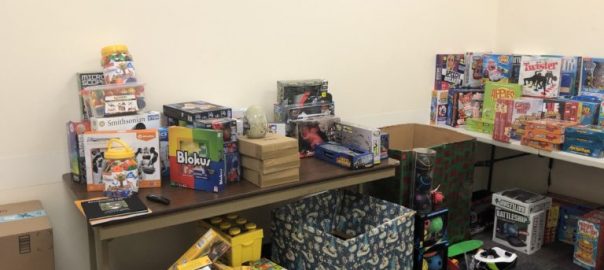
The holidays tend to bring out the best in all of us, and that is especially true of our partners and insureds at Northeast Treatment Centers. NET is already an incredible organization, with over 800 compassionate and professional staff members providing a continuum of trauma informed behavioral health and social services to 10,000 consumers annually. These services include: mental health, addiction treatment, foster care, residential group care, adoption, juvenile justice services and child welfare services. These activities increase exponentially over the holidays, specifically through the efforts of their annual toy drive and “adopt a family program”. In order to help with these efforts, NSM Insurance Group is proud to present NET with a $10,000 donation to be used across all programs.
The toy drive collection serves families within the NET Community Care (child welfare) program in addition to children and youth receiving behavioral health services and children whose parents are receiving addiction treatment. In 2018 NET raised over $12,000 as well as received hundreds of toys to be distributed to 300+ families and 650+ kids. The adopt a family program also made a significant impact, with 20+ families adopted through NET’s donor network and 50+ families adopted specifically by the Volunteers of America’s holiday program.
“We are so proud to work with such an incredible organization in NET and its even more amazing to experience firsthand the impact they can make in the community through efforts like the toy drive and adopt a family program”
Sean Conaboy, Insurance Advisor, NSM Insurance Brokers
“We are extremely appreciative of NSM’s generous donation! Our holiday programs would not be possible without the support and commitment of our generous partners and donors. The families that NET serves face many complex issues and for many of them poverty is just one of their struggles. Our hope is that by providing toys and gifts during the holidays we are able to alleviate some of stress and bring a little joy and happiness to families and their children”
Karla Eyre, Grants Manager, NET
If you would like to contribute to these amazing programs, don’t worry, there’s still time! The easiest way is to order the toys directly through Amazon, where NET has set up a Shopping List to make orders and deliveries convenient and fast. Simply go smile.amazon.com and search for “NET” under Charity Lists. If you do not have an AmazonSmile account, then you will be asked to create one before you can search the “Charity Lists”. If you have already purchased new and unused toys, they can also be dropped off at NET: 499 N. 5th St., Suite A, Philadelphia, 19123
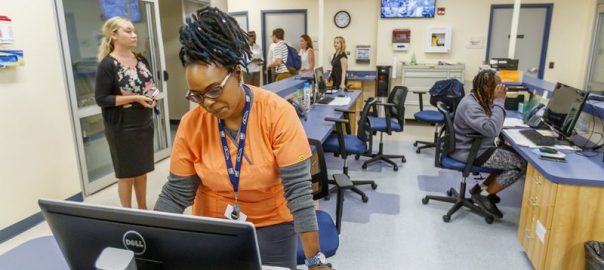
Getting a person into addiction treatment often hinges on a single moment — when they feel ready to seek help.
But for people with opioid addiction, the pain of withdrawal means that moment can pass quickly, replaced by powerful urges to use again to make the misery stop. Waiting for a treatment center to open for the day may be out of the question. Detoxing in the waiting room at a crisis center or an emergency room, or trying to navigate treatment options while dealing with nausea, vomiting, craving and cramps, can squelch the strongest desire for sobriety.
That’s why city officials hope Access Point, a 24-hour treatment center that marked its official opening Wednesday, can better serve a population often deterred by red tape and long wait times.
City officials say it’s another step toward offering treatment on demand throughout the city, long a goal of Philadelphia’s behavioral health department.
For people in addiction seeking treatment, “that window of opportunity can be very narrow,” said David T. Jones, the commissioner of the city’s Behavioral Health and Intellectual disAbility Services. “If someone says they’re ready and the system trips them up, that’s a loss for them, and for the community.”
Access Point, which is run out of the Northeast Treatment Center, an addiction treatment nonprofit on Spring Garden Street in North Philadelphia, has served 306 people in opioid addiction since its “soft opening” in April. On Wednesday, it expanded to allow access to people addicted to other substances like benzodiazepines, cocaine, and alcohol.
Patients don’t need identification to enter or to be prescribed medication-assisted treatment — another common barrier to the treatment widely accepted as the gold standard for opioid addiction.
Stays in the 15-slot unit can last no more than 23 hours; the idea, said NET director Regan Kelly, is to stabilize patients enough to place them in more long-term treatments. In the unit, patients can be dosed with suboxone, a medication-assisted treatment that is an opioid; used as directed, it staves off the cravings and withdrawal pains that send people back to using, without creating euphoric effects. From there, staffers can transfer patients to inpatient or outpatient treatment, depending on what they need. And though some choose to detox without the help of medication, Kelly and Jones said they’re working to dispel the stigma that’s often attached to medication-assisted treatment — that patients are just replacing one drug with another, explaining that this is their best chance at lasting recovery.
“People continue to die in the face of evidence that medication-assisted treatment is the gold standard,” Kelly said.
So far, the unit has not had trouble locating longer-term treatment options. Jones said that of the 12,000 medication-assisted treatment slots in Philadelphia, 3,000 are still open.
“We think we’re going to fill those slots,” Kelly said.
About 113 patients who have come through Access Point opted for medication-assisted treatment, the agency said; 84 opted against it. 171 patients were referred to inpatient treatment; 43 were able to start an outpatient program, and 53 left against medical advice. (Those numbers don’t include patients who came into the center with acute psychiatric or medical issues and had to be taken to emergency rooms or crisis centers.)
Everyone who wanted treatment has been able to access it within that 23-hour window, Kelly said. Some have entered and left for treatment within four hours, she said. And about 40 Access Point patients came directly from the four heroin encampments in Kensington, two of which were cleared a month after the center opened.
Sheila Ford, NET’s community outreach coordinator, who goes to the remaining encampments twice a week trying to persuade people to seek treatment, said it is invaluable to be able to offer immediate help — even in the middle of the night.
Alone with their thoughts, outside in the quiet, she said, is often when people are most receptive to the idea.

By the time Ruby Morales-Negron was 16, she had lived with four different foster families.
She was so determined to find a permanent home that she was willing to leave Philadelphia. She got to know Carly King – an adoption supervisor – on road trips to mixers for eligible adoptive parents and foster kids.
They went to bowling alleys in Millersville, roller rinks in Lancaster. King would urge Ruby to stay optimistic as she left each awkward activity without a meaningful connection. The two talked on the car rides back to Philadelphia about what Ruby wanted for her future and the sting of being an older kid continuously passed over for younger children.
“It’s something that has always pulled on my heartstrings,” King said. “They are such sweet and loving individuals yet I would chronically see foster parents opt to adopt younger kids, watching foster kids age out, entering the world on their own, without support and it would eat me up.”
On Nov 9, two weeks before Ruby’s 18th birthday, King adopted her. The two celebrated Friday in a room filled with colorful balloons and the happy shrieks of young children. Ruby was the oldest of the 20 kids honored on National Adoption Day, put on by the Department of Human Services.
Ruby was one of 1,100 youth awaiting adoptions in Philadelphia. Thirteen percent are over the age of 13. When young adults turn 18, they age out of the system or, in some cases, choose to receive DHS assistance until they turn 21. Many struggle to stay on their feet and become homeless.
“Coming into my teen years, I knew I actually wanted a family I wanted to be in a household with someone I could call mom,” Ruby said. “Carly was always my back-up person. She was always there for me.”
Ruby entered the system at age 9 after her mother died and family members couldn’t – or didn’t – step up.
She was placed into foster care where family after family said they were happy to provide a short-term home but didn’t want to adopt.
In 2014, Ruby was placed in a pre-adoptive home. Things went well at first but then the mother got a new boyfriend and her attitude toward Ruby shifted.
“I felt very uncomfortable,” Ruby said. “She didn’t believe what I was telling her; she didn’t talk to me as much as you should talk to your child.”
On top of that, Ruby felt unwanted attention from the boyfriend. Worried it could escalate, she called Carly, whose number she had kept from those car rides.
King, who works at Northeast Treatement Centers, one of the city’s privately contracted social service agencies, got the call in the middle of a training session on how truama affects a child’s self esteem.
“She was in crisis mode,” King said.
Single and 28, King did not anticipate becoming a foster mother but she also knew first-hand the struggles that young adults without a family face.
About four years earlier, King had received a similar call. Alexis Hearst, a young woman who she knew from a summer camp in Philadelphia, had lost her financial aid at college and was now homeless in Georgia.
The young woman’s family had stopped answering her pleas for help.
King mailed her a plane ticket back to Philadelphia and took her in.
Now all three women; Alexis 22, King, 29, and Ruby, live in a three-bedroom home in Northeast Philadelphia. The girls call her “sister mom.”
They have matching lockets and enjoy frequent living-room dance parties, watching musicals in their pajamas and 1 a.m. trips to Wawa.
They also support each other. All three women lost their mothers at young ages. King has also gotten both girls into counseling, working and focused on school.
King knows she and her girls are lucky. She understands the often complex child welfare system and the resources in the city to help her daughters stay on the right track.
“When I hear other young people aging out of foster care, I think about Alexis trying to navigate financial aid without support and I think about Ruby… how would she know how to get car insurance or change a flat tire? I’m glad that these two have family but there are so many teens out there that don’t and as a system we have to do better.”
In May Ruby will graduate from CAPA and has applications in at seven schools, most of them local.
She’s excited about college but not sure if she wants to live on campus.
“I just moved in,” she said, nestling into King. “Why would I leave so soon?”
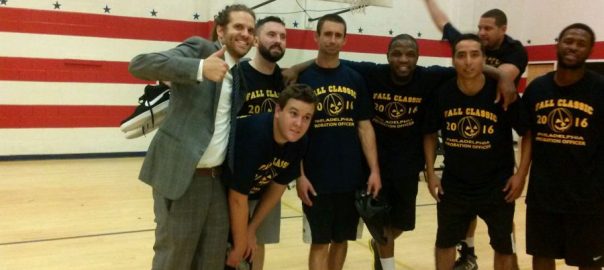
The bleachers at the MLK Recreation Center at 21st and Cecil B. Moore Avenue were packed as community members came out to see the 3rd annual Fall Classic All Star Game. The exhibition game, celebrating the start of Juvenile Justice Week, featured youth from the Philadelphia Providers’ League playing against an all-star team of juvenile probation officers.
Inside the rec center, volunteers collected candy for a safe, neighborhood Halloween event (see sidebar on Page 2) and tables were set up to provide youth and community members with information about different services and programs. Among those represented were the Defender Association of Philadelphia, the Police Athletic League, the Philadelphia Technician Training Institute and Northeast Treatment Centers.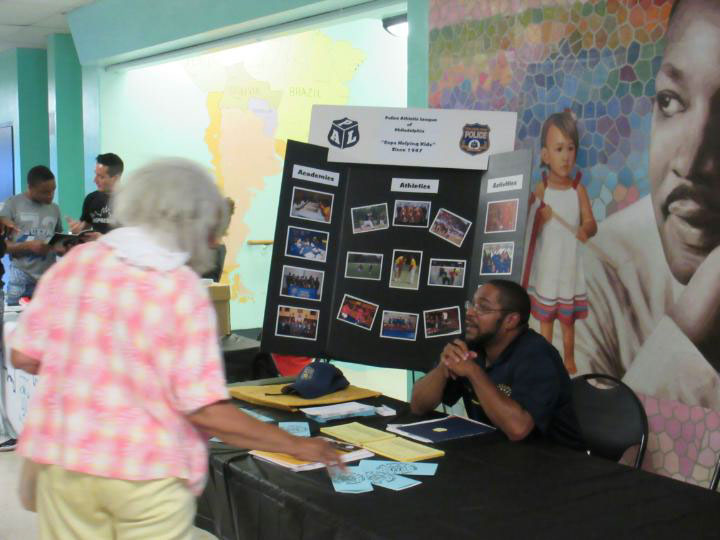
Leonard Thompson, who used to play basketball in the MLK Recreation Center, was now there on behalf of Philadelphia Technician Training Institute. Thompson applauded the informal nature of the event. “I think it’s fantastic,” Thompson said. “It builds connections. It builds relationships.”
Children from the community had a shoot-around and socialized before making way for the all-star teams to take the court for pregame warm-ups. The feeling in the room was optimistic, if not a bit competitive.
“They’re already starting to talk some trash,” Adam Serlin said with a smile.
Serlin is the Director of Court Services with Northeast Treatment Centers, one of the organizers of the event. Of the many organizations involved, many are helping kids in the juvenile justice system stay in the community and at home instead of placement facilities.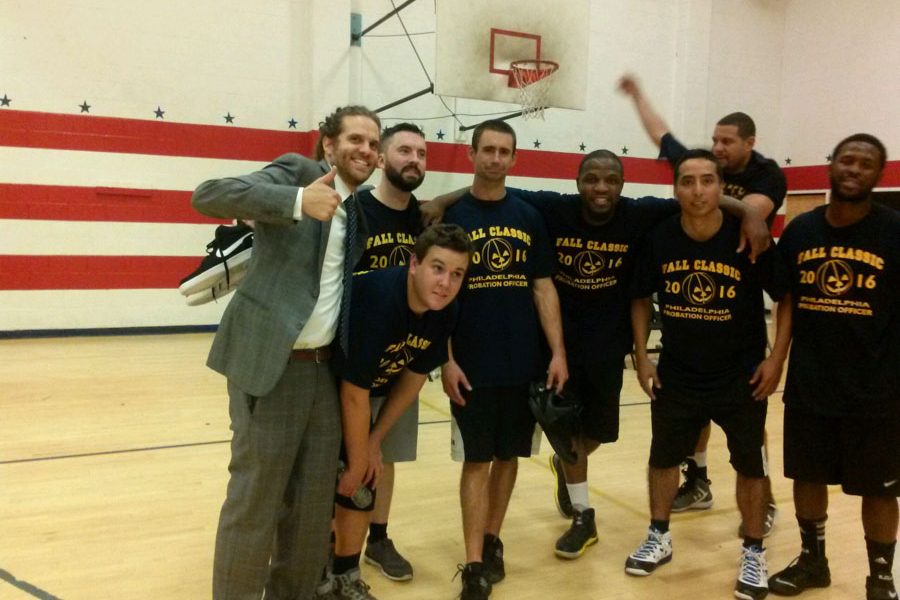
Before long, the ball was tipped and the youth tried to take advantage of age being on their side with a mixture of full court press defense and a wide-open fast-break offense. By halftime, they had built a 14 point lead.
Halftime allowed community members to mingle with judges and other city officials and a dance routine was performed by the North Philly Bearcats.
An unexpected highlight came during the second half when the Special Ops Drumline, who practices at MLK, took the court for an impromptu and rousing performance. The thunderous drums echoed through the gym as numerous spectators pulled out their phones to record the moment.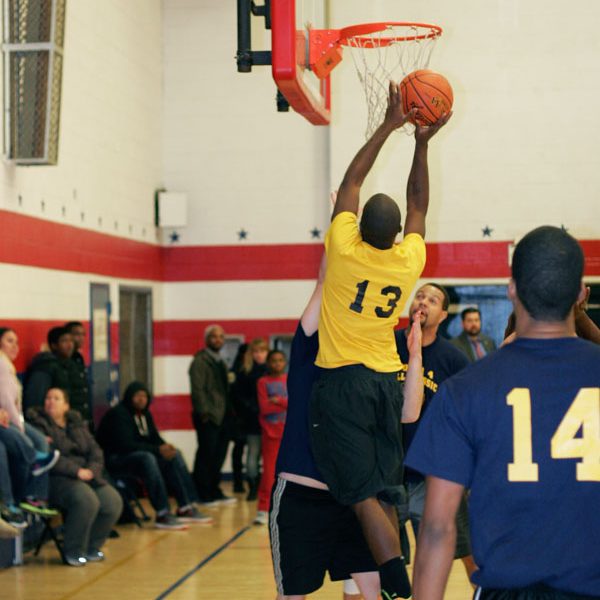 The lead elapsed in the second half as the game went back and forth down the stretch. With 12.5 seconds left in the game, the probation officers inbounded the ball, down by a score of 52-49. One of the officers got off a decent look as the seconds ticked away, but the shot didn’t drop as the youths took a 2-1 lead in the all-star series.
The lead elapsed in the second half as the game went back and forth down the stretch. With 12.5 seconds left in the game, the probation officers inbounded the ball, down by a score of 52-49. One of the officers got off a decent look as the seconds ticked away, but the shot didn’t drop as the youths took a 2-1 lead in the all-star series.
Both teams lined up to shake hands and share laughs as the annual trophy was brought to half court.
According to officials, Showing the probation officers in a different light was one of the many reasons to organize the game. “This informal interaction hopefully reveals to our young people that we are all humans like them,” said Angel Flores, Deputy District Attorney for the Juvenile Division. “And that we are all working together to try to better their situations.
A drive to show citizens that agencies were there to help them and their families was a consistent theme of the night. “We want people to call us and engage us,” said Jose Loya, Communication and Development Manager with the Defender Association of Philadelphia.
The association was on hand with informational pamphlets and representatives educating attendees on how they can help, something Loya says is much easier when they lose the shirt and tie and get out into communities. “We’re also recognizing that there are barriers to services, and I think one of the great things NET is doing is trying to tear down some of those barriers,” Loya said.
The collaboration between the juvenile court system, public defender’s office and the many other organizations at work that night are a sign to Adam Serlin that the city is moving in the right direction. “Everyone’s kind of working together,”Serlin said later. “I do think in Philadelphia we have a pretty progressive juvenile justice movement.”
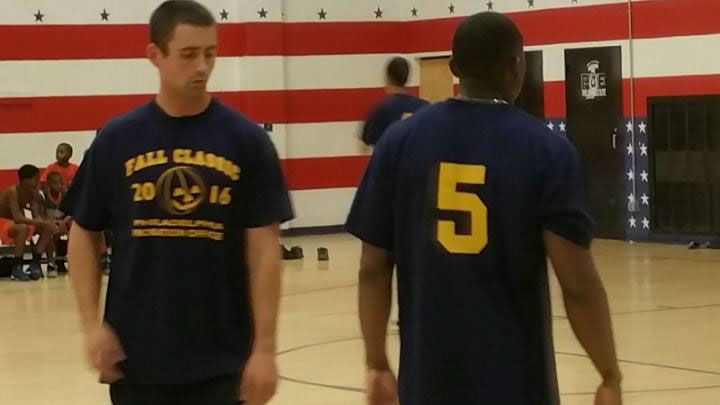 Serlin cited research that showed that sending juveniles to placement facilities is often not best for adolescents. It may not be best for the city either as the average cost of placement nationwide is approximately $88,000 per child, per year.
Serlin cited research that showed that sending juveniles to placement facilities is often not best for adolescents. It may not be best for the city either as the average cost of placement nationwide is approximately $88,000 per child, per year.
A number of kids participating in the Fall Classic All Star game are currently enrolled in a program that gives kids in the juvenile system a chance to stay in their communities. Northeast Treatment Center’s Evening Reporting Center is a six month program that allows kids to report daily from 4 to 8PM as an alternative to placement facilities. The center includes cognitive behavioral therapy, financial literacy classes, and career training among other programs. There is even a recording studio on the premises.
Serlin said that the program gives a second chance for mostly non violent offenders, many who are in trouble due to technicalities or probation violations. “We already know that teenagers are impulsive,” Serlin said. “But that doesn’t mean that they’re bad kids or bad people.”
The Evening Reporting Center and Fall Classic All Star game are just two of the many reasons Serlin is excited to about the state of the city’s outlook. “It’s an exciting time to work in juvenile justice system here.”
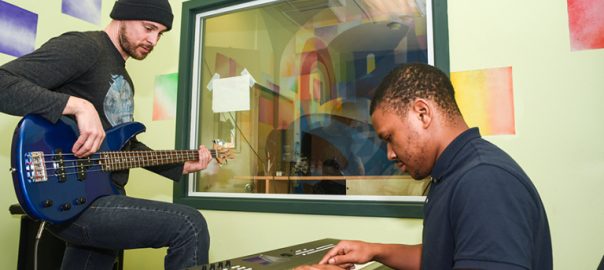

The young boys at the Evening Reporting Center are writing their own soundtrack in the juvenile justice system.
“At ERC we be learning/ getting some jobs in return,” rings out through the speakers in the sound booth in the recording studio, which sets up Lee’s verse. “Here they teach us about real life/ not ‘x to the two’/ they should come to my school/ teach a lesson or two.”
Just hours ago, Lee was released from house arrest. At 4 p.m., he promptly arrived at the Northeast Treatment Center at Second and Norris streets – this time, on his own accord.
For the past six months, Lee has been one of the adjudicated delinquent youths under the community-based supervision of the Evening Reporting Center. He’s been working with his peers to put together a theme song for the ERC and voluntarily came to the music program today to use the third-floor recording studio.
The kids at ERC are all given a second chance. Instead of being sent away to a juvenile detention center, they are placed under supervision in their communities.
After school lets out, youths arrive to the court-mandated, alternative placement program. They are supervised between peak crime hours, 4-8 p.m., then return home – their GPS ankle monitors make sure of it.
Here, they learn to cook meals for one another, to plan finances and to develop social connections through music, art and sports. The creative alternative to juvenile detention “works to view the whole child,” says Adam Serlin, ERC program director and former musician.
“It’s not always what the child did. It’s what has been done to the child,” Serlin says. At the ERC, he says they first ask, “What are the ways we can address the deeper causes for behavior?”
In other words, the program pays special attention to rehabilitation instead of punishment.
Through the juvenile justice system, the ERC works with the Department of Human Services and Philadelphia Family Courts to provide community supervision during the length of house arrest. To provide music programming as a form of creative expression, the ERC is partnered with the nonprofit Limelight Arts.
“We give them interests they can connect to so moving forward, they’ll have some new passions that can prevent issues or recidivation in the future,” Serlin says.
Co-founders Frank Machos and Avery Coffee provide ongoing opportunities for the at-risk youths to build tangible skills in music. Machos utilizes his role as the director of music education for the Philadelphia School District to help secure equipment for the ERC and place kids who complete the program into school music programs after the end of their sentence.
His partner, Coffee, visits the program every Wednesday to provide hands-on music instruction. For Coffee, watching kids engage with unfamiliar instruments as an act of creative expression is what makes this program special.
“They get to have a voice,” Coffee says. “In this system, you’re getting talked down to constantly. You’re constantly surrounded by adults who don’t understand your situation. They aren’t looking you in the eye. They’re writing stuff down and you’re getting passed down the line. In here, you get to say what’s on your mind. This is your outlet. You’re not just a number.”
It was Serlin’s goal to create pro-social programs that would allow his kids to feel heard and find a productive way to let off steam.
“Our kids are not different than any other kid,” Serlin says. “A lot of times they just have fewer programs to go to and fewer things to do. That typically leads to trouble.”
Serlin identified music as a transferrable skill that can be carried anywhere and used as a coping mechanism if the child has issues at home.
“Music helps me express myself because I can get stuff off my chest,” Lee says. “If I’m having an issue with something, I can rap it and it will relieve it a little bit.”
The measurable successes of the Evening Reporting Center in its pilot year have allowed the branch to expand from a pre-adjudicatory program that supervised youths awaiting trial, into a six month post-adjudicatory program that serves as a true alternative to juvenile detention.
According to the DHS, in 2014, 82 percent of youths placed in Philadelphia ERCs were successful in exiting the juvenile justice system.
Fajr, a 17-year-old alumnus from West Philadelphia, was one of them. The skills he learned in the music program landed him internships with Jr. Music Executives and PhillyCAM before being hired to measure data by the ERC.
“If you’re interested, everything is in your reach,” Fajr says as he sits behind a keyboard in the live music room, mindlessly pressing keys as he speaks. “They’re not asking you to do anything except play music. I was blind to everything when I came in here. They presented me with ideas that worked in my own head.”
The ultimate goal of the Evening Reporting Center is to provide at-risk youths with skills for rehabilitation. They aren’t looking to make a star of every kid that walks in the studio. Instead, they are focused on the healing power of music and the potential of a second chance.
“Even if it’s just making the process a little more palatable throughout, making their journey through the juvenile justice system something that is a little less terrifying, that’s a success,” Serlin says.